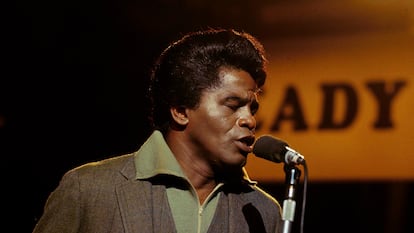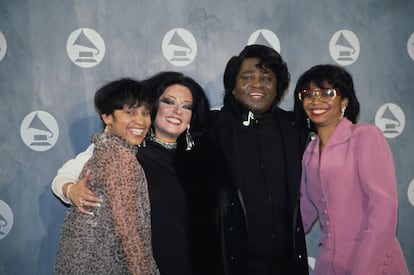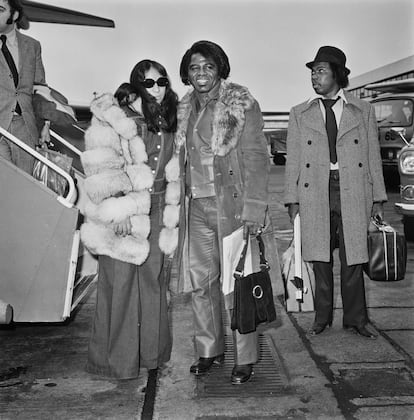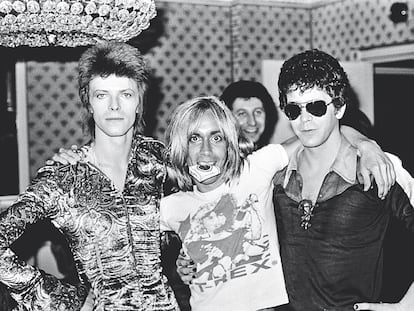The shadows and light of James Brown’s chaotic life: massive music, pioneering civil rights work — and spousal abuse
A new documentary produced by Mick Jagger and two of Brown’s sons show new sides of the late funk innovator, whose immense estate has been under dispute for 15 years. “For a time, I didn’t like my father,” shares his daughter


When the 1960s dawned in the United States, the decade ushered in a new wave of Black innovators. Some, like Malcolm X, Angela Davis, Martin Luther King, communicated new dreams through the legal system, religion and political pressure. Others, thanks to popular culture, were able to arrive in previously unexplored territory. One of these groundbreaking artists was James Brown, composer and singer, a man from the South of humble beginnings. In August 1968, four months after the assassination of King, Brown wrote and recorded Say It Loud — I’m Black and I’m Proud, which would soon become the official anthem of his community and the Black Power movement.
The force that lay in Brown (born in 1933 in South Carolina and raised in Georgia, where he also died in Christmas 2006), was evident throughout the lifetime’s worth of 900 songs that the funk innovator released. Today, 17 years after his death, his legacy is put into perspective by a new documentary that was produced by his daughters and Mick Jagger. But just as it exalts his musical career, it reveals his personal challenges. Viewers learn of abuse to which Brown’s father subjected his mother (who ended up running away from the family home), and that Brown replicated in his own chaotic, complex and violent relationships. The artist wed four times and had nine children, both in and out of marriage.
Over the course of the four episodes, A&E’s James Brown: Say It Loud, directed by the artist’s daughter Deborah Riley Draper, addresses Brown’s power in establishing a unique sound, bringing that sound to the people, and building a recognizable identity through music. With vintage footage and interviews with people who were fans during both his era and the present moment, one can appreciate how his impact has evolved. “Black’ is a [bad] thing that was basically put on …the Black man in America. And hey, I’m Black and I’m proud, but I really don’t want to have to say, ‘I’m Black,’ [as if] you had to say, ‘You’re white.’ I want to say that we’re people and that we’re brothers and that we got the same fight,” Brown says in the documentary’s archival footage. After King’s death, the fight for civil rights evolved, and the world Black took on new meaning, thanks in part to Brown’s song.

Chuck D, of New York hip hop crew Public Enemy, remembers being a child when the track was released. “That song was dangerous, aggressive and political. But I’m eight years old […] All I know [is] it’s funky, I’m saying the word ‘Black,’ and we ain’t ‘colored’ no more.” The rapper Questlove, drummer, co-founder of The Roots, and film director (he made his directorial debut with the acclaimed Summer of Soul, which premiered at Sundance Film Festival a few years ago), is also one of the film’s co-producers. He explains that, “It’s probably one of the most bravest things and the most political thing that James Brown has ever done.” Jagger himself says that, for him, Brown was “a brilliant performer, who inspired me from the beginning and was deeply committed to the civil rights movement.”
There’s no doubt that Brown’s musical and political message was potent, but an artist’s artistic and personal sides don’t always run along parallel lines. Chaos reigned in his relationships. At just 16 years old, he was sent to jail (from which he managed to get out early when another prisoner, a singer, discovered the mastery of his gospel voice), but Brown’s life was complicated from the beginning. His mother Susie had him when she was also just 16, and she suffered abuse and mistreatment from his father, Joseph — so much so, that she decided to leave him and their five children and flee to New York. That harsh and violent behavior was reflected in the singer’s own marriages.

Brown wed his first wife, Velma Warren, in 1953. They separated in 1969, although when the singer died in 2006, she tried to argue that they had never signed divorce papers and thus, she had right to his estate. Her claim was rejected. With her, Brown had his four eldest children: Teddy (who died in a traffic accident at 19), Terry, Larry and Lisa. At the same, in the mid-’60s, the artist was in relationships with two singers: Yvonne Fair, with whom he fathered his daughter Venisha (who died of pneumonia at the age of 53 in 2018) in 1965; and Beatrice Ford, with whom he had another son, Daryl, who published a biography of his father in 2014.
After their divorce came Brown’s most high-profile marriage, with Deidre Jenkins. They wed in 1970 and split up four years later, although they wouldn’t get divorced until 1981. They had two daughters, Deanna (now 55 years old) and Yamma (now 51 years old). The former is the head of the James Brown Family Foundation, which keeps her father’s legacy alive. The latter wrote a book about the musician a decade ago. The two of them are also co-producers of Say It Loud, and are fond of telling interviewers about how they hope the documentary will introduce their father to younger generations. In a conversation with a local publication in Georgia, Deanna affirms that her father is still “the most sampled artist in hip hop”, but that those who grew up with him will also learn from the film. “My father narrates this documentary. And he talks about controlling his own destiny. I think that’s so important for young folks to be able to understand, that you can find, follow and control your own destiny,” she says. “This is an opportunity where we get to go back to an original and a person who was an original in this business. And not just in the music business, a civil rights icon. He was so deep into that as well. But also too, he was a brother from Augusta, Georgia.”

“We look at him in his entirety, not just the music,” continues the director. “And we see his life born during the Depression, buck danced during World War II, he cut his first record during the Korean War, he shot to fame in the ‘60s, and he created the most important anthem, edict, and tenet for our culture. Say it loud. I’m Black and I’m proud. That was a gift to us. It was a lesson to us. But it’s also something that’s incredibly important because we, for 400 years, have self-silenced. We weren’t allowed to speak. We weren’t allowed to congregate. And Mr. James Brown stood up and said say it loud. Use your voice. Own your narrative. Those are the best lessons for anyone. Our generation, the next generation and the ones after.”
In an interview with People, Yamma and Deanna explain that their childhood with their father was not easy. “When you see a family member being hurt, you’re not feeling the best about the person that’s hurting them,” says the former, in reference to how their father abused their mother. “I was flat-out upset, mad with my dad at that moment. I still go back to that place every now and then, not to belittle my dad, but flashing back over my own life and the domestic violence situation in my life, thinking how much of that shaped me.” Yamma recalls how once, when she was just six years old, she leapt up to defend her mother when Brown was going to strike her. That was the last time it happened. By unveiling those moments, the sisters try to give context to their family, to show their humanity, and to talk about what happened and how they healed. Deanna acknowledges that the very presence of their father was “intense”. “There was a time when I didn’t like my father. I didn’t like him because of this type of behavior. I saw a lot growing up. I heard a lot growing up that could have damaged me for a lifetime. He never had any type of rage towards us because we were his children. That was a situation between a husband and a wife,” she says, explaining that their father always asked his wife for forgiveness. “Not to say that that was something that just erased everything, but also knowing that he had compassion in his heart and my mom was receptive to that.”
After that divorce, Brown married again, this time with Adrienne Rodriguez in 1984, with whom he had no children. During their relationship — which was marked by frequent breakups and reconciliations — he was arrested various times for abusing her. In fact, it was during this period that he spent three years in jail, for fleeing from the police. He was convicted for possession of weapons and spent time in treatment for his drug consumption. Rodriguez died in 1996 and he started living with Tomi Rae Hynie, his fourth and last wife — or maybe not. It turns out when they got married, Hynie was still wed to another man in Texas, and they had never officially divorced. She would later get that marriage annulled, but she never officially married Brown again. In June 2001, they had the musician’s ninth and last son, James Joseph Brown II, and in 2003, they separated, though they continued to live together. After the death of the singer in 2006, she presented herself as his legal widow, despite the fact they had never legally wed. Things got complicated and the fights over inheritance delayed Brown’s burial for three months. These disputes took a long time to resolve: his $100 million was the subject of court cases for more than 15 years.
What Brown wanted was for the majority of his estate to go towards building schools and soup kitchen for underprivileged children from the South. But that did not prove to be an easy wish to fulfill. Hynie tried mightily to get a share of her partner’s estate — no less than the South Carolina Supreme Court declared that she was not his legal widow in 2021. Three other people claimed to be Brown’s children, his official heirs wanted their money and made hasty legal decisions (rights sales, among others). The situation was complex, to say the least. As the attorney general and then-governor of South Carolina was quoted The New York Times in 2014, it was a “labyrinth created by the entangling lawsuits filed by everybody against everybody.” Brown’s “oceanic discography”, as it was described by critic Diego Manrique, has been overshadowed by his life and legend.
Sign up for our weekly newsletter to get more English-language news coverage from EL PAÍS USA Edition
Tu suscripción se está usando en otro dispositivo
¿Quieres añadir otro usuario a tu suscripción?
Si continúas leyendo en este dispositivo, no se podrá leer en el otro.
FlechaTu suscripción se está usando en otro dispositivo y solo puedes acceder a EL PAÍS desde un dispositivo a la vez.
Si quieres compartir tu cuenta, cambia tu suscripción a la modalidad Premium, así podrás añadir otro usuario. Cada uno accederá con su propia cuenta de email, lo que os permitirá personalizar vuestra experiencia en EL PAÍS.
¿Tienes una suscripción de empresa? Accede aquí para contratar más cuentas.
En el caso de no saber quién está usando tu cuenta, te recomendamos cambiar tu contraseña aquí.
Si decides continuar compartiendo tu cuenta, este mensaje se mostrará en tu dispositivo y en el de la otra persona que está usando tu cuenta de forma indefinida, afectando a tu experiencia de lectura. Puedes consultar aquí los términos y condiciones de la suscripción digital.
More information
Archived In
Últimas noticias
There is as much life left to discover on planet Earth as that which is already known
Dozens presumed dead, around 100 injured in fire at Swiss Alps bar during New Year’s celebration
Is porn for women different from conventional porn? We spoke to those who make it
Cartagena de Indias is sinking: What can the city do to mitigate it?
Most viewed
- Reinhard Genzel, Nobel laureate in physics: ‘One-minute videos will never give you the truth’
- David King, chemist: ‘There are scientists studying how to cool the planet; nobody should stop these experiments from happening’
- Oona Chaplin: ‘I told James Cameron that I was living in a treehouse and starting a permaculture project with a friend’
- Sinaloa Cartel war is taking its toll on Los Chapitos
- The Interoceanic Train, the Mexican alternative to the Panama Canal










































